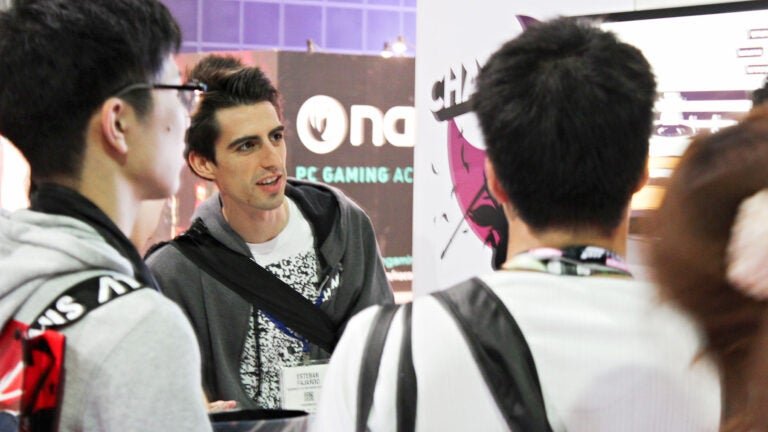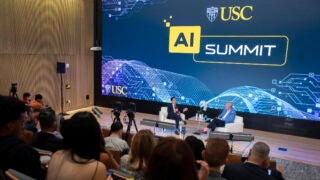
Esteban Fajardo, lead designer on Chambara, walks a group of visitors through a demo of the game at the E3 convention. (Photo/Andrew Good)
E3 is the place to be for gifted gamers
USC Games grads turn out in force for the annual entertainment expo offering talented designers a venue to get valuable feedback
Trojans were well represented at this year’s E3, the annual Electronic Entertainment Expo. There’s no event gamers watch more closely: For three days in June, media descends on the Los Angeles Convention Center to cover the announcement of the year’s biggest titles.
For recent graduates of USC Games — one of the top-ranked game design programs in the country, according to The Princeton Review — E3 is a major career opportunity. It gives professional exposure to the projects they developed in school, putting their titles in front of news media, business contacts and other developers. Besides being a venue where participants can make connections, E3 gives designers a chance to receive feedback on their projects.
Below is a selection of USC-affiliated games that were on display.
Chambara
Keeping your eyes peeled is the key to this multiplayer death match in which you play a ninja that can disappear into each level’s monochromatic background. Chambara, one of the launch titles to come from USC Games Publishing, is due out on commercial consoles (including PS4 and Xbox One) on July 27. In 2015, it took home the “Ones to Watch” award at the British Academy of Film and Television Arts video game awards.
This was the game’s second appearance at E3; it exhibited last year at the Indiecade booth. This year, it was a nominee for the conference’s College Competition.
Project lead Kevin Wong said that E3 was critical for networking. The game’s team was approached by several contacts representing microconsoles — a growing field of low-cost systems from companies like Razer and Google.
“There are a lot of companies here looking for content for their ecosystems,” Wong said. “That’s a growing market, and they’re looking to incubate and cultivate games there.”
Catherine Fox, lead designer on the game, said getting a student project into competitions and trade shows like E3 can also help the development process. It can spur feedback from other developers that helps drive the end product. Now that Chambara is finished, of course, that’s not something the team needs.
“Once we graduated, we devoted our full time to getting it on to consoles,” Fox said.
https://www.youtube.com/watch?v=PSkuN-OJUFc
Octobo
Even the most diehard gamer’s heart would melt upon seeing Octobo. The adorable, plush octopus toy comes with a children’s book and a program for tablets. By sliding a tablet into the toy, Octobo can come alive and react to events in the book’s narrative.
“We realized parents were already playing with kids on their tablets, but that interaction felt very flat and boring,” said technical lead Julian Ceipek. “We wanted to bring back the joy of physical toys.”
The current version of the toy is a prototype, Ceipek said. For the creative team, E3 was an opportunity to meet potential investors and manufacturing contacts. The team is currently working with a manufacturer to figure out how to bring the toy to market. It’s also considering doing a Kickstarter in the near future.
“At USC, the focus is on design, but we do start to branch out and learn about business,” Ceipek said. “Being at E3 continues that process.”
Inner Activity
E3 is a place that largely embraces lights and distraction, which made Inner Activity stand out. In a mysterious tent tucked in a corner of the Indiecade area was a uniquely meditative virtual reality experience.
Players get to explore a surreal landscape while wearing a subpac, a kind of combined subwoofer and vest that vibrates the body and provides a relaxing physical dimension to the game.
Anshul Pendse, the creative lead behind the project, said he was inspired to create the game after going on a 10-day meditation retreat. He wanted to provide people with a similarly meditative experience through technology; Inner Activity does this by stimulating all the senses. In addition to music and natural audio samples, the team uses fans and essential oil sprays to immerse players in the game’s environment — near a river or deep in a jungle, for example.
“We’re using game technologies to be more than entertainment — you can think of it as mindful entertainment,” Pendse said. “When we think of video games, we think of overstimulation. We’re using VR to give people a peaceful experience.”
Pendse said E3 was a valuable opportunity to get playtest data, both from other developers as well as non-game designers. He hopes Inner Activity could be used in therapeutic contexts.
Beautiful Corner
Not every game to come out of USC looks like it belongs in an arcade. For Martzi Campos’ MFA master’s thesis, she led the design of Beautiful Corner, a kind of art installation that looks like a corner of someone’s bedroom. As you rifle through a chest of drawers in the room, you begin to piece together a larger story through a series of letters between a character who has grown up and their childhood friend.
As the story unfolds, new discoveries unlock different drawers, along with triggering changes in the music and lightning.
“We’re creating an atmosphere,” said Kyle Laporte, the game’s composer and a recent graduate from the Scoring for Motion Pictures and Television program at USC.
“The game plays on themes of childhood magic and experiencing a journey with a pen pal who may or may not be real. It’s a kind of scavenger hunt to discover whether this magical world exists or not and whether you choose to believe it or go back to being your ordinary adult self.”
Campos said she was inspired by works like Cathy’s Book, a young adult novel that came packaged with ephemera from the characters in the story. She was also inspired by escape rooms — interactive experiences in which people solve puzzles to exit a room.
“Escape rooms are really popular right now, but people are always trying to escape from escape rooms,” Campos said. “I wanted to create a space where people could sink in and become a character in this space.”



